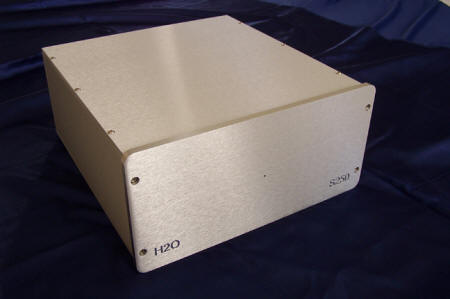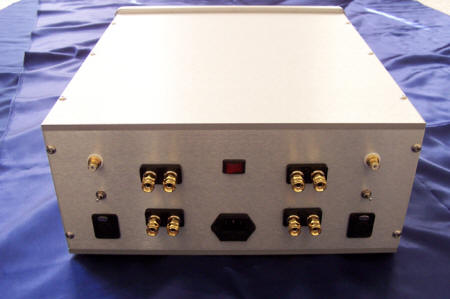You are reading the older HTML site
Positive Feedback
ISSUE
24
h2o
S250 amplifier
as reviewed by Larry Cox

|
LARRY COX'S SYSTEM
LOUDSPEAKERS
ELECTRONICS
SOURCE
CABLES
ACCESSORIES
|
This review grew out of my ownership of inefficient ATC speakers. I love the sound of tubes, but ATCs are inefficient and require lots of power. This usually means lots of money, and money is always a consideration. On the 6moons site, Srajan Ebaen waxed rhapsodic about a digital amplifier (based on Bang & Olufsen's I.C.E. module) by a company called H2O. Srajan not only commented about the H2O's Stygian bass, but suggested that it warranted comparison to a tube amplifier. I thought the H2O could be the ticket for my ATCs, so I contacted the amp's designer, Henry Ho. By the time I received the $3000, 250-watt H2O Stereo 250, I no longer owned the ATCs, but in the meantime, the audiophile press had been dripping with reviews of digital amps, so I thought I should look at what digital amplification had to offer. Like many, I wondered if digital amplifiers would push aside the old guard because they were new and better, or just new.
For those not in the know, I.C.E. stands for Intelligent, Compact, and Efficient. The I.C.E. module is certainly compact—about 3.5 inches square—and is quite efficient, producing 250 watts with a cool operating temperature. As for its intelligence, I can't say. A wealth of information about the module is available on the B&O website (go to www.beoworld.co.uk/icepower1.htm).
While you can hold an I.C.E. module in the palm of one hand, try two hands for the 62-pound H2O 250. One small nit to pick is that the speaker terminals aren't color coded for positive negative, so you'll need to look for the tiny stamp indicating that positive and negative terminals. The amp comes in the standard silver or black. Its plain look will not offend most people, though I can't imagine that it will tickle anyone's fancy either. The break-in, however, may annoy even the thick-skinned. In my system, the amp sounded very strange until it had been played for around 150 hours. During that time, the sound alternated between okay and truly awful and back again. Sometimes the soundstage was in front of the speaker plane, at other times part of it was in front and part in back, and for a few days the entire stage moved into the right rear corner of my listening room. No other product has ever done that! During its break-in phase, the H2O 250 sounded forward, and though not bright, it verged on being unrelenting. I do not like forward, unrelenting sound, so I was hoping the sound of the amp would improve. Thankfully, it did.
Let's cut to the chase. Is the H2O 250 a new way to get tube sound? If not, does it sound like solid state? The answer to both questions is no. It did not sound like a tube amplifier, nor did it sound like a solid-state amplifier. It sounded both a little tubey and a little transistor-like. Did it sound like the real thing? No, but then, no amplifier, whether tube or solid state, sounds like live music, except at moments. My initial impression was that the H2O 250 was amazingly detailed, so much so that it made my tube monoblock amplifiers sound lacking. Bass was also tauter, deeper, and more present with the digital amp. There may have been more top end extension, but perhaps it was just different. Imaging also seemed more precise. Instruments stood crisply at attention, though they lacked the body that my tube amps provide. The amp was warm, yet detailed. It had a sparkle in the upper midrange, not to be confused with a crispy or hot sound. The H2O 250 impressed me with its vivid presentation, its excellent rhythmic qualities and its near-crystalline clarity. Although the amp sounded more exciting than relaxed, it was not etched, bleached, or lean. The amp had a liquidity that is usually the domain of tube gear, though it did not have a "tube sound." The H2O lacked the warmth and inner light that characterizes the best tube gear.
No part of the frequency response curve seemed to stand out. The bass was tight, controlled, fast, and textured, inviting me to play tracks with ridiculous bottom end just to hear what H2O could do. The bass on my wife's Celine Dion CD (I swear it's hers, not mine!) was overblown, as it is with my reference tube amps or my ATC SIA 150 integrated. However, when bass was in line with the rest of the music, rather than hyped-up or surgically enhanced (as it is on the Celine Dion disc), the H2O went so deep that the overtones could take the bass out of rhythm with the rest of the music. Fans of synthesized music might find this problematic. Had I not reached for foolish bass tracks instead of sticking to the mostly acoustic music I listen to, I would not have had that impression.

Midrange voices and instruments were vivid and a bit cool rather than warm and relaxed. Artur Rubinstein's rendering of Grieg's Piano Concerto No. 1 seemed to have an extra tinkle during crescendos. The vividness also showed up with male voices, which sounded quite immediate, though a deeper voice like Joe Williams' was missing the slow warmth it has with my tube amps. Steve Forbert's vocals on Mission of the Crossroad Palms sounded a little raspier and sharper than it does with my tube amps, though a bit less crispy than it does through my ATC integrated. Female voices sounded a bit more forward than usual. On What's New, Linda Ronstadt sounded less warm and throaty, and a bit tilted up. Returning to Celine Dion, her duet with Luciano Pavorotti revealed the trained singer's superior and far more emotionally authentic (albeit more formal) skills. That was no surprise, but it was a nice surprise to hear that the differences were apparent through the H2O.
In the treble region, the H2O had detail like that of solid-state gear that costs many times as much, though it lacked the inner light, and the warmth and emotional involvement, of the best tube gear. The high-hat percussion on Ry Cooder's Chicken Skin Music was appropriately splashy, with a good sense of speed, though not the warm part of its ringing. With great tube gear, I often find myself unconsciously moving up onto the podium and mingling with the cymbals, but this did not happen with the H2O 250.
After moving my own tube amplifiers back into the system for a few weeks, then again replacing them with the H2O 250, I felt that there was a lot to like about the digital amp. I did not hear the grainy or eviscerated leanness of solid-state amplification, nor did the 250 shovel detail through my speakers, pushing me into another room with an overly vivid, screechy sound. To get a clearer sense of the difference between the sound of the 250 and that of either tube or solid-state amplifiers requires an analogy, so bear with me. I'll take you into the mountains to describe the difference, because it was in the mountains that I bumped into digital without knowing it.
My wife and I were at 9000 feet in the eastern Sierra Nevada, in a coffee shop looking at a beautiful print, over 24 x 32 inches in size. The photograph had been made in an area we had just hiked through. There was no indication that it was a digital image, but by analyzing the picture and making some deductions, we concluded that it was digital, then confirmed it with the owner of the restaurant. Though the picture was beautiful, we were bothered by something that was hard to identify. It wasn't the subject, the composition, or the color. After about fifteen minutes of scrutiny, we finally noticed that everything was in really intense, sharp focus. The quality of focus not only made Ansel Adams' work look downright weak, it made our trip through the meadow seem out of focus. This was not how film captures images, nor how the human eye focuses on objects.
Much as digital photography differs from both film and the human eye, the H2O amp sounds different from tube amps, solid-state amps, and the original event. There is a definite sense of reality, but some features of music pop out more than they do in real life. This amplifier is a bargain at $3000. It sounds robust and detailed without crossing over into nastiness. Because of its slightly cool midrange, I would pair it with a warm-sounding speaker. I wish I could have heard the H2O 250 with my ATC 35s. That might have been a match made in heaven. With my cool-sounding Ensemble Figuras, the H2O 250 did not give heavenly results, but finding the right match is a fundamental part of this hobby. Larry Cox
Specifications
- Output Power: 250 watts/500 watts into 8/4 ohms
- THD + N: 0.1%, 10Hz < f < 20kHz at 500watts
- Voltage Gain: 27dB
- Bandwidth: 6Hz - 80kHz into 8ohms
- Input Impedance: 8 Kohms
- Output Impedance: 0.005 ohms
- Minimum Load Impedance: 2 ohms
- Dyanmic Range: 117dB
- Inputs: Both Single Ended and Balance are available
- Outputs: Bridge Balance with Dual Binding Posts
- Chassis Dimension: 15" W x 15.5" D x 6.5" H
- Weight: 62lbs
H2O S250 amplifier
Retail: $3000
H2O
web address: www.iceh2oaudio.com
